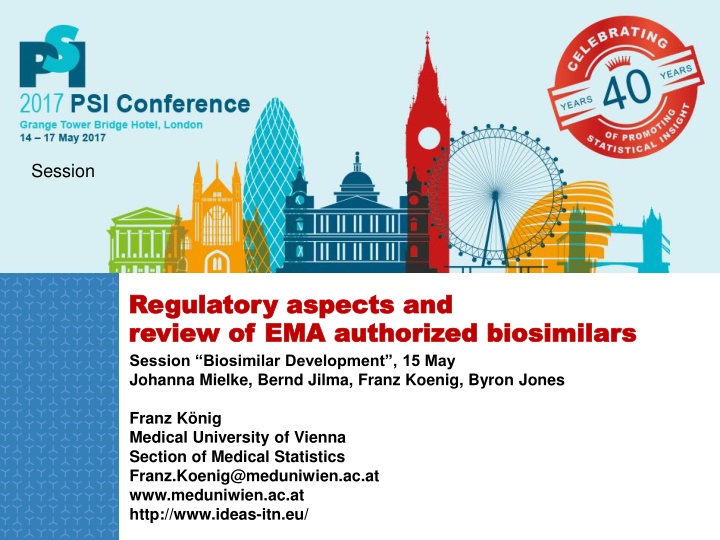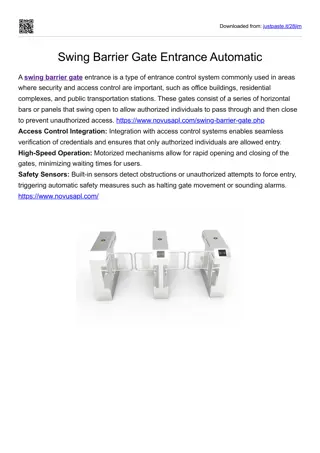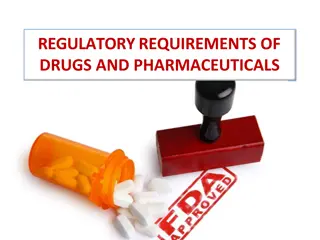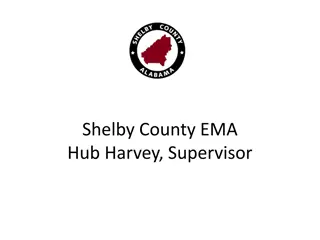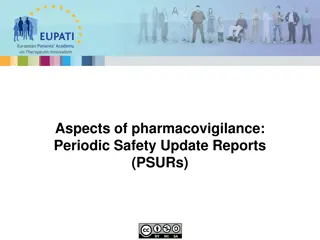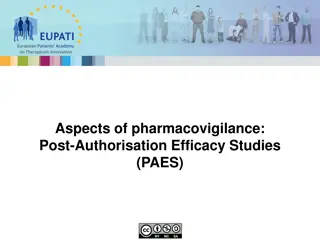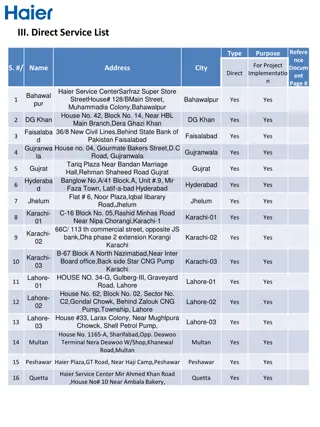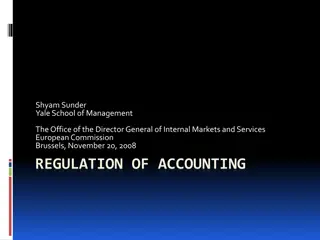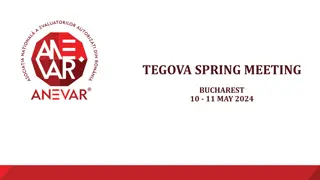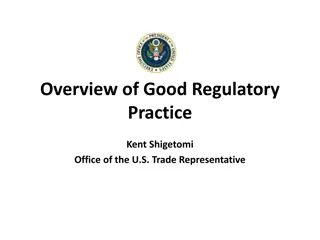Regulatory aspects and Regulatory aspects and review of EMA authorized review of EMA authorized biosimilars
Session on the regulatory aspects and review of EMA-authorized biosimilars development, covering the types of clinical trials required for approval in Europe, differences in development programs, unified approaches for biosimilars with the same active substance, adherence to EMA guidelines, and addressing multiplicity in planning and analyzing trials. The session delves into the main data sources and methods used for assessing biosimilars in Europe, providing valuable insights for stakeholders in the biopharmaceutical industry.
Download Presentation

Please find below an Image/Link to download the presentation.
The content on the website is provided AS IS for your information and personal use only. It may not be sold, licensed, or shared on other websites without obtaining consent from the author.If you encounter any issues during the download, it is possible that the publisher has removed the file from their server.
You are allowed to download the files provided on this website for personal or commercial use, subject to the condition that they are used lawfully. All files are the property of their respective owners.
The content on the website is provided AS IS for your information and personal use only. It may not be sold, licensed, or shared on other websites without obtaining consent from the author.
E N D
Presentation Transcript
Session Regulatory aspects and Regulatory aspects and review of EMA authorized review of EMA authorized biosimilars Session Biosimilar Development , 15 May Johanna Mielke, Bernd Jilma, Franz Koenig, Byron Jones biosimilars Franz K nig Medical University of Vienna Section of Medical Statistics Franz.Koenig@meduniwien.ac.at www.meduniwien.ac.at http://www.ideas-itn.eu/
Acknowledgements & Disclaimer This project has received funding by the Swiss State Secretariat for Education, Research and Innovation (SERI) under contract number 999754557 (Novartis: JM, BJo) and from the European Unions Horizon 2020 research and innovation programme under the Marie Sklodowska-Curie grant agreement No 633567 (MUW: FK, BJi). The opinions expressed and arguments employed herein do not necessarily reflect the official views of the Swiss Government and should not be linked to any affiliations the authors are associated with. http://www.ideas-itn.eu/ 2
Introduction: BIOSIMILAR A biosimilar medicine is a biological medicine that is developed to be similar to an existing biological medicine (the reference medicine ). [...] When approved, its variability and any differences between it and its reference medicine will have been shown not to affect safety or effectiveness. Source: Christian Schneider, Chair EMA Biosimilar Working Party: http://www.ema.europa.eu/docs/en_GB/document_library/Medicine_QA/2009/12/WC500020062.pdf 3
Questions Which type of clinical trials have to be undertaken for getting approval in Europe? How much and in which way do the development programs differ? Is there a unified approach for biosimilars with the same active substance? How close are the studies in the submitted applications following the recommendations in the EMA guidelines? How is multiplicity addressed when planning and analyzing biosimilar trials? 4
Main Data Source European Public Assessment Reports (EPAR) Available online at http://www.ema.europa.eu Detailed information about the application: Drug: active substance, indications, ... Non-clinical: toxicology, ... Clinical development program: study design, endpoints, sample size, ... EMA leading agency with 28 approved biosimilars on 11 different biologics (April 2017) Review conducted in June 2016 (Mielke et al., 2016) 5
Methods: EPARs analysed Review based on 21 approved biosimilars on 7 different biologics (June 2016) Focused on approved biosimilars (no refused, no withdrawn products) Sponsors collaborated & submitted identical clinical trials, but products were marketed separately Example: biosimilar to active substance epoetin zeta Silapo (Stada Arzneimittel AG) - Retacrit (Hospira UK Ltd) 13 different applications 6
Methods Comparison of the submitted applications in terms of Sample size/Number of clinical trials Trial design Endpoints Statistical models Equivalence margins Approved indications, extrapolation to other indications 7
Overview of results First Biosimilar in 2006 8
Sample size PK/PD vs. Phase III PK/PD trials 1-5 trials 24-269 subjects Phase III 1-3 trials 120-1295 subjects Number of PK/PD trials Number phase III trials 9
Sample size PK/PD vs. Phase III Epoetin Alfa/Zeta Follitropin Alfa Filgrastim Infliximab Others 10
Sample size PK/PD vs. Phase III Epoetin Alfa/Zeta Follitropin Alfa Filgrastim Infliximab Others 11
Trial design PK/PD Guidelines: 2x2 crossover, mostly followed Exceptions: Remsima/Inflectra (parallel groups design, but was allowed in product specific guideline) Epoetin Alfa Hexal/Abseamed/Binocrit (pivotal PK/PD is a parallel groups design, contradicts product specific guideline) Phase III Parallel groups design recommended, followed Exceptions Zarzio/Filgrastim Hexal and Grastofil/Accofil (single arm design, but accepted in product specific guideline) 12
Endpoints, equivalence margins & statistical models: PK Metrics for bioequivalence testing: AUC, Cmax Approach: calculation of geometric mean ratio with confidence intervals, if confidence intervals fully lie within pre-specified limits bioequivalence Recommendation in guideline for PK studies: Equivalence margins: 80-125% 90% confidence intervals Mostly followed, exceptions: Silapo/Retacrit: wider equivalence range for Cmax Ovaleap, Benepali: no details given in EPAR and publication, unclear if formal testing was done 13
Endpoints, equivalence margins & statistical models: PK If criteria are not fully fulfilled, approval is possible: Example Zarzio/Filgrastim Hexal: PK/PD-studies in five different doses, for lower doses and after multiple subcutaneous doses: AUC and Cmax not within limits Sponsor claimed differences in level of purity adjustment to doses Nonetheless, for three settings outside of equivalence region Sponsor provided modelling results and explanations for mechanism of action approval 14
Endpoints, equivalence margins & statistical models: PK Grastofil/Accofil: Study KWI-300-101 15
Endpoints, equivalence margins & statistical models: PK The location and the width of the confidence interval should also be taken into account in the interpretation of similarity. For example, statistically significant differences in 90% CIs within the justified acceptance range regarding relevant PK parameters would need to be explained and justified as not to preclude biosimilarity. On the other hand, if the 90% CI crosses the prespecified boundaries the applicant would need to explain such difference and explore root causes. Source: http://www.ema.europa.eu/docs/en_GB/document_library/Scientific_guideline/2015/01/WC500180219.pdf 16
Endpoints, equivalence margins & statistical models: PD PD 3 applications without any PD assessment Endpoints are drug specific Equivalence margins: 80-125% or narrower Example Epoetin Alfa Hexal/Abseamed/Binocrit: the acceptance range was then changed to 97 103% by protocol amendment based on haemoglobin (Hb) concentration changes defined as equivalence margins in Phase III studies Similarly to PK, approval is possible if not all endpoints meet the target 17
Endpoints, equivalence margins & statistical models: Phase III Phase III Endpoint, margins, statistical models are disease specific Margins: no explicit explanation for choice n in publications and EPAR Mainly one primary endpoint Only few exceptions (with 2 and 4 primary endpoints) No multiplicity adjustment in EPARs mentioned 18
Endpoints, equivalence margins & statistical models: Phase III 19
Endpoints, equivalence margins & statistical models: Phase III Endpoint, margins, statistical models are disease specific Variation within a substance: Ovaleap and Bemfola (follitropin alfa) Same endpoint used (number oocytes retrieved) Slightly different equivalence margins Statistical methods Ovaleap: Zero-inflated Poisson (ZIP) regression model Bemfola: Mann-Whitney TOST or Schuirmann s TOST (data dependent) Flexibility for the sponsors how to analyse the data 20
Indication & Extrapolation Phase III in one indication only, but approval in all indications of the reference product Extrapolation Only in 2 out of 13 applications, the approved indications are not essential identical to the one of the reference product Example for not all indications granted: Silapo/Retacrit Reduction of allogeneic blood transfusions in adult non-iron deficient patients prior to major elective orthopaedic surgery was not granted Reason: lack of shown equivalence for the subcutaneous administration route in Phase III 21
Indication & Extrapolation Example of successful extrapolation: Remsima/Inflectra One Phase III trial in patients with active rheumatoid arthritis According to the EPAR, the sponsor provided: A literature review of the therapeutic indication and also of the mechanism of action of the drug Preliminary data on 23 patients with either Crohn's disease or ulcerative colitis Additional post-marketing trials were promised Licensed for all indications of the reference product (rheumatoid arthritis, ankylosing spondylitis, psoriatic arthritis, psoriasis, adult and paediatric Crohn's disease and adult and paediatric ulcerative colitis) 22
Multiplicity Multiple hypothesis tests several doses, routes of administration (IV, SC), different populations, endpoints (e.g.,Cmax, AUC), If ALL test must be significant, NO adjustment needed BUT not always all tests have been statistically significant. What about defining the success criteria differently? success : k out of m tests are statistically significant What is the impact on sample sizes needed? 23 PSI Conference 2017
For k out of m: which multiple testing strategy? Bonferroni (might be too conservative, but controls FWER) No adjustment (inflation of FWER for k<m) Or aim at controlling a different error rate instead of FWER: the k-FWER k-FWER = P(reject at least k true null hypothesis, irrespectively which and how many are true null) k-FWER adjustment: ? =? ? ? Lehmann & Romano (2005), Hommel & Hoffmann (1998), Victor (1982) 24
Results 25 PSI Conference 2017
Results 26 PSI Conference 2017
Results 27 PSI Conference 2017
Results 28 PSI Conference 2017
Results 29 PSI Conference 2017
EPARs Very helpful to evaluate regulatory standards Even more helpful if reports were more standardized Length (25p 105p) Depth of information differs Unified structure (e.g., including overview tables on PK/PD trials) All crucial information should be included (e.g., explanation for choice of margins) EPARs should be linked to other EMA transparency initiatives E.g., EudraCT should be mentioned for all trials mentioned in EPAR 30 PSI Conference 2017
Conclusions High variability between submitted trials High variety also within an active substance case by case decision of the regulators Recommendation in product specific guidelines and overarching guidelines were mostly followed, but also exceptions Align sample sizes for multiple tests and success criteria It is possible to gain approval even though not all pre-specified primary endpoints meet the target 31 Business Use Only
References Mielke, J., Jilma, B., Koenig, F., & Jones, B. (2016). Clinical trials for authorized biosimilars in the European Union: a systematic review. British Journal of Clinical Pharmacology, 82(6), 1444-1457. OPEN ACCESS: http://dx.doi.org/10.1111/bcp.13076 Mielke, J., Jones, B., Jilma, B., & Koenig, F. (2017). Sample Size for multiple hypothesis testing in biosimilar development. Submitted. 32
This project was supported by the Swiss State Secretariat for Education, Research and Innovation (SERI) under contract number 999754557. The opinions expressed and arguments employed herein do not necessarily reflect the official views of the Swiss Government. The project is part of the IDEAS European training network (http://www.ideas-itn.eu/) from the European Union s Horizon 2020 research and innovation programme under the Marie Sklodowska- Curie grant agreement No 633567. Thank you
